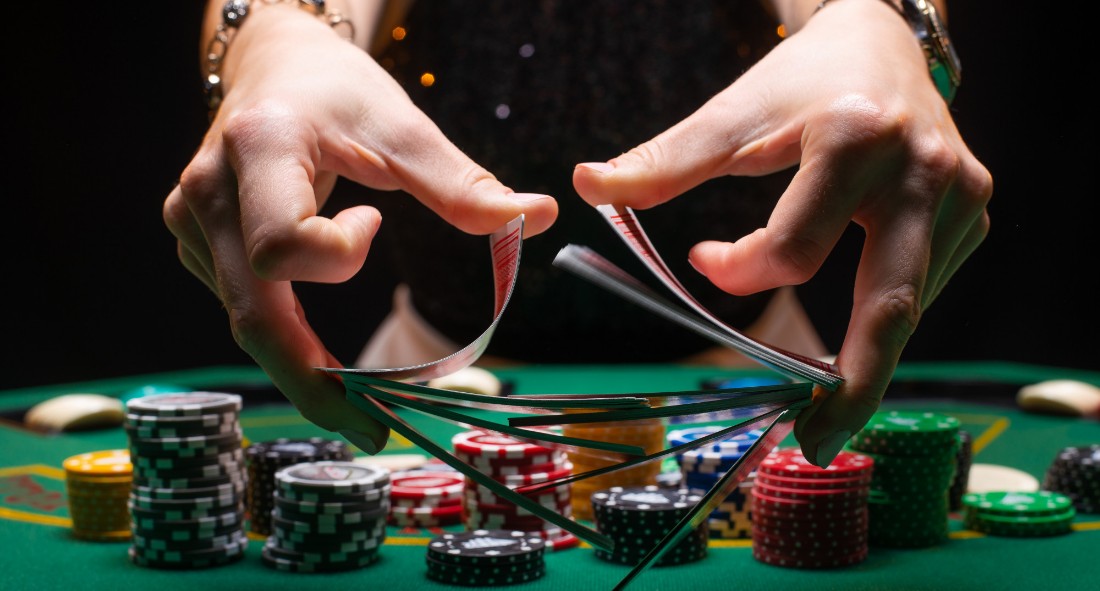In most blackjack variants, the house has an advantage of around 0.10%. However, in Blackjack Switch, the house edge is reduced from 0.10% to 0.5%. This makes Blackjack Switch a massively popular game. There are some changes in the rules to compensate for the Switch ability. However, when using a proper strategy, it can truly be an advantageous game to play.
Blackjack Switch Rules
In Blackjack Switch, the rules are fairly standard. In most cases, the blackjack variant is played with 6 decks of cards that are shuffled into a shoe. The way to beat the dealer is to have a value as close to 21 as possible. Whoever exceeds 21, goes bust. This means automatically forfeiting the hand.
Blackjack Switch follows the same standards as regular blackjack in regards to card values. That is to say, Ace equals 1 or 11, face cards (Jack, Queen and King) are all worth 10 and number cards keep their face values. Thus, in order to form the strongest hand – Blackjack – you will be required to match an Ace with a 10-value card. This is known as Blackjack and beats any other hand – except another Blackjack which ends in a push.
Once the player has placed their bets, the dealer begins the round by serving cards. You will receive two face up cards to each of your hand positions and the dealer will receive a face-up and face-down card. At this point, you will have the chance to being your turn but can also choose to Switch. This exchanges the two top cards of each hand. Once you have chosen to Switch – or not – you will have the chance to take one of these actions:
- Stand- you are happy with your hand and do not wish to take any more cards.
- Hit – you choose to receive an additional card. You can hit as many times as you like but must be cautious not to go bust.
- Double – you choose to take a single additional card and double your bet in doing so.
- Split – you split your cards – provided they are matching (pairs). By splitting cards, you double your bet and play the two hands independently. Splitting aces means you can only receive one more card to each hand. It is also possible to Double after splitting.
- Insurance – you choose to place an insurance bet if the dealer is revealing an Ace. This costs half your stake. If the dealer has Blackjack, you win 2:1 – essentially meaning you claim back your stake.
Once you have completed your turn, the dealer will proceed to play theirs. At first, the dealer reveals their face down card to show their total. In Blackjack Switch, the dealer stands on all hard 17s and hits on all soft 17s. Any hand that has an ace in it is considered a soft hand. In Blackjack Switch, the only main difference is that any time the dealer has 22, the round is considered a push, rather than a loss for the dealer.
Whenever you beat the dealer’s total, the payout is worth 1:1. The same goes for Blackjack – which usually pays 3:2 but is only 1:1 in Blackjack Switch. An equal round results in a push and the same goes for the dealer having 22, unless you have Blackjack, in which case, the dealer’s 22 loses.
How to Use Blackjack Switch Basic Strategy
In Blackjack Switch, the main strategy you have to know is when to use the Switch. In some cases, such as the one listed in our introduction, it is fairly obvious. However, there are other cases where Switching may not be that clear. That is why we have provided some basic strategy tips to boost your chances of making the Switch.
To use Blackjack Switch strategy, first you have to be able to categorise each card’s value. There are three values – Strong, Weak or Deuce. Here is how we categorize them:
- Strong: 7, 8, 9, 10, J, Q, K, A
- Weak: 3, 4, 5, 6
- Deuce: 2
You should use these values to decide the strength of the dealer’s card. After doing so, you will have to decide what type of hand you have. There are four different types of hands – Winner, Loser, Push and Chance. Whenever you wish to define these hands, you should always assume that the dealer’s face down card is a 10 and any player hand that needs a hit will receive a 10.
Winner
Essentially, a Winner hand is any hand in which the player has more than the dealer – when assuming that the dealer’s facedown card is 10. This includes Blackjack and any hard or soft hands from 18 to 20. In addition, Winner hands include player totals of 8 to 11 that beat the dealer’s face-up card. An example of this is a player 9 against a dealer 6. If the player can split a pair, it will be a Winner if the individual cards compare as Winners against the dealer’s face-up card. Because the dealer does not bust on 22, the 2 is considered a Deuce card for the dealer. Thus, you only have Winner hands against a dealer 2 if you have either 10, 11, 19, 20 or 21.
Loser
A Loser hand is any hand that is beaten by the dealer’s Strong face-up card. For instance, if the dealer is revealing a Jack, the player has a Loser hand if they have a combination of 18.
Push
A Push hand is when the player hand and dealer’s face-up card combine to equal. For instance, if the players hand is worth 19 and the dealer reveals a 9, this hand would be considered a push – provided the dealer lands a 10-value card.
Chance
Essentially, a Chance hand is a hand where you cards are weak, but so is the dealer’s total. If you have a soft or hard hand with a total of 3 to 7 or 12 to 17 this could be considered as a Chance hand if the dealer’s face-up card is 2 to 6.
As you may assume, the best to worth hands are Winner, Push, Chance and then Loser. Once you have familiarized yourself with this, you will be able to keep this in mind whenever you play. There are a total of nine different combinations of these hands. Here is how they rank:
- Winner/Winner
- Winner/Push
- Winner/Chance
- Winner/Loser
- Push/Push
- Push/Loser
- Chance/Chance
- Chance/Loser
- Loser/Loser
Examples
The player is dealt a 9 and Ace on one hand and a 7 and 10 on the other. The dealer’s face up card is an 8. In this scenario, the player has a Winner/Loser hand. However, if they make the switch, the player has a Winner/Push hand.
The player is dealt a 10 and an Ace on one hand and a 9 and 10 on the other whilst the dealer is revealing a 10. This results in having a Winner/Loser hand. If the player switches, they will have a Push/Push hand. In the chart above, we see that a Winner/Loser hand is better than a Push/Push hand. Thus, the player should not make the switch.

 Spin Rio Casino
Spin Rio Casino Queenplay
Queenplay The Best Play’n GO Slots to Play in 2022
The Best Play’n GO Slots to Play in 2022 How to Play Punto Banco
How to Play Punto Banco












